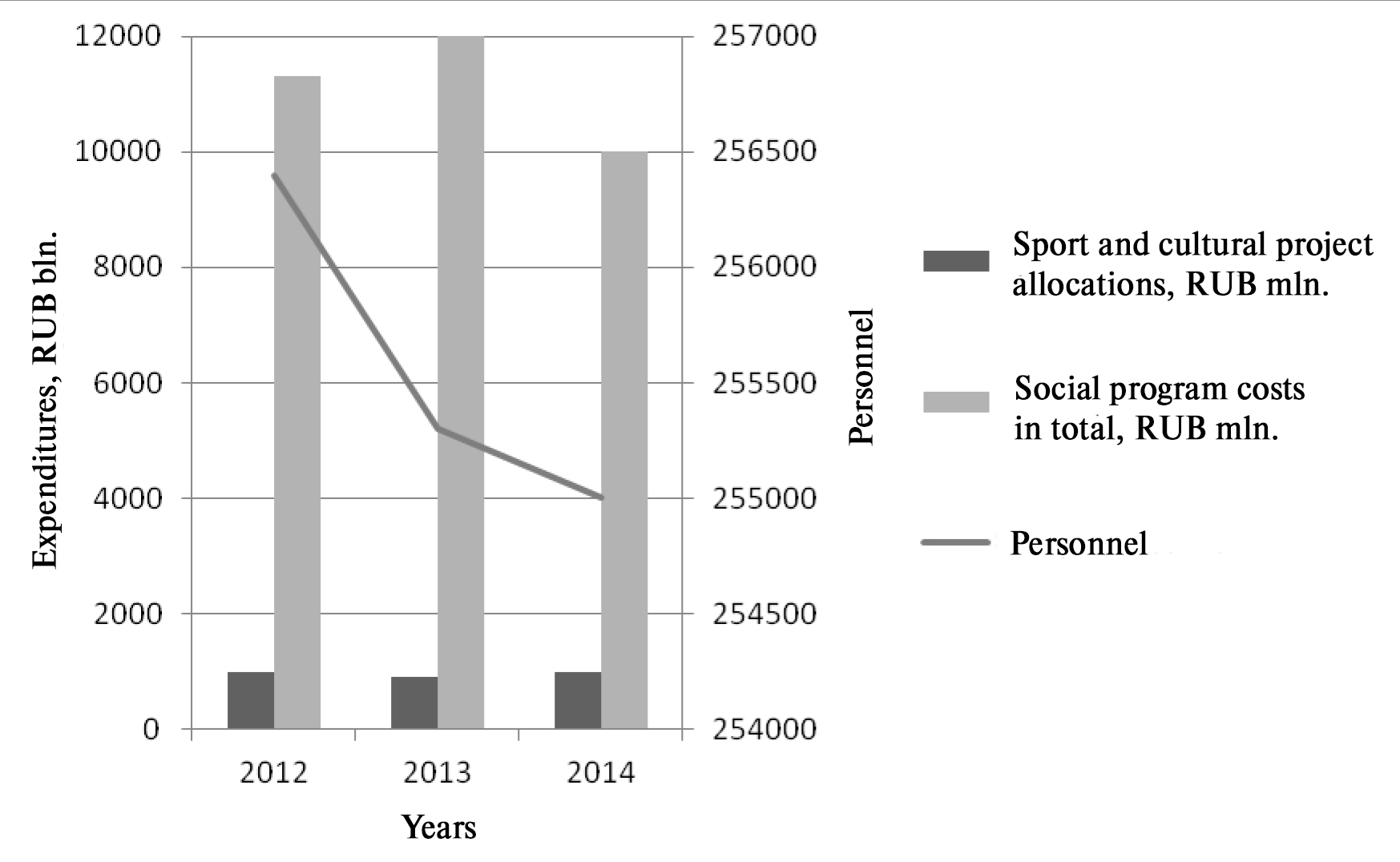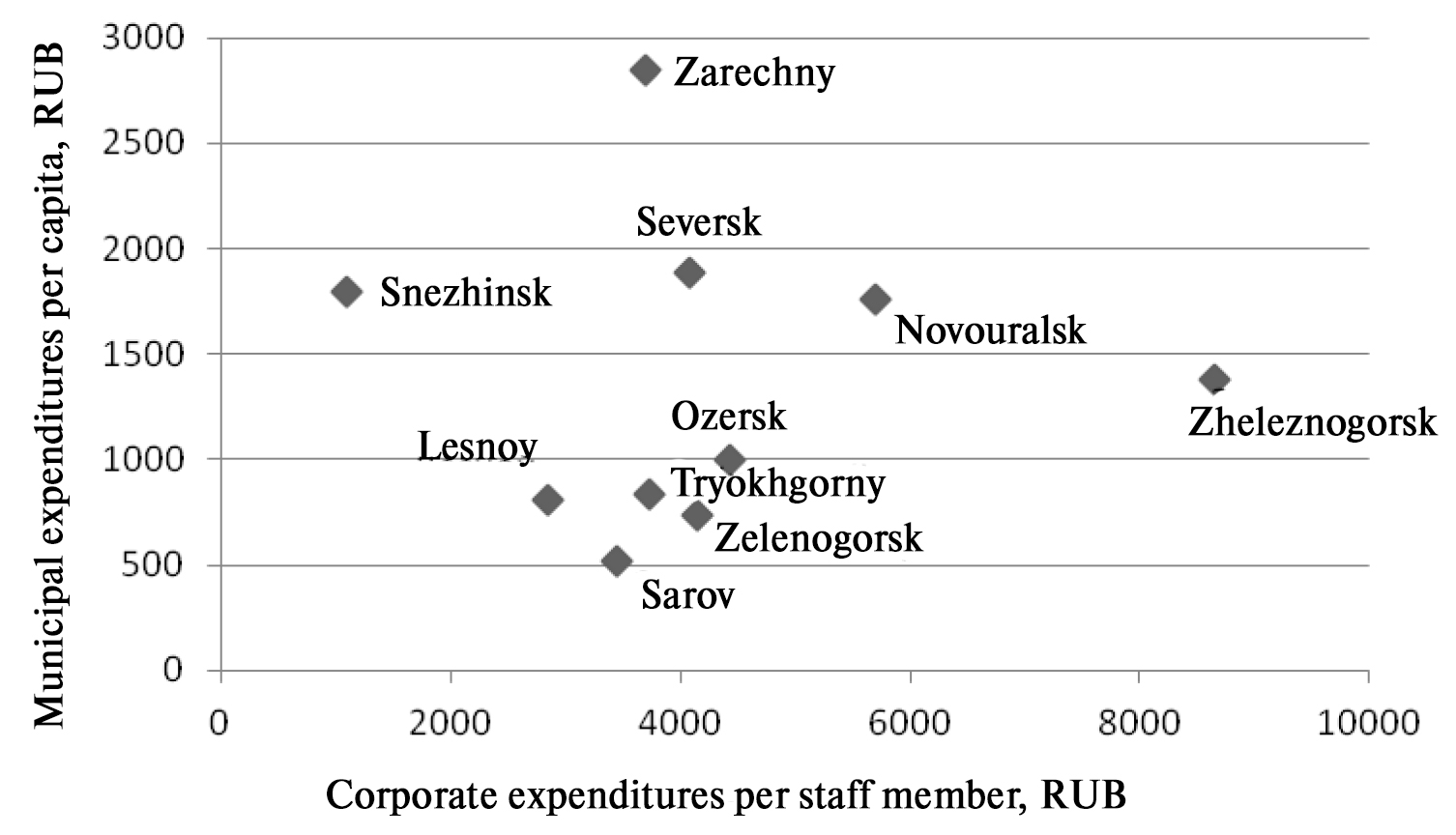Physical culture and sport sector financing situation analysis for Rosatom State Corporation hosting cities
Фотографии:
ˑ:
PhD T.V. Letaeva1
Associate Professor, Dr.Sc.Econ. E.A. Popova1
PhD A.V. Romanova1
PhD D.V. Fedulov1
1South Ural State University (National Research University), Chelyabinsk
Keywords: Rosatom SNEC, sport sector financing, social programs
Background. Sports are widely acknowledged the world over and by the relevant international organizations as an efficient economic development tool that at the same time facilitates the human and social resource accumulation processes in the sporting areas [2]. Sustainable development of any area varying from municipal level to the national one is impossible unless supported by the relevant human resource. There are quite a few sets of development rating indices proposed by many researchers for the growth sustainability assessments with the relevant economic, social and environmental development rating factors. A municipal growth sustainability index, for instance, takes into account the following human resource development costs: education, health protection, physical culture and sports costs etc. [1]. It should be noted in this context that the physical culture and sports sector financing efficiency rating methods are still being subject for many serious discussions [3].
Presently the Russian government maintains a few unique territories formally referred to as the Closed Administrative Territorial Divisions (CATD) subject to special residence control regulations dictated by the government security interests. There are 44 CATD in the Russian Federation on the whole at present under control of the Rosatom State Nuclear Energy Corporation, Ministry of Defence and Roscosmos State Cosmic Industry Management Corporation.
Population of these closed territories is mostly concentrated at this juncture in ten largest CATD under control of the Rosatom SNEC making about 750 thousand people in total. Rosatom SNEC has been giving increasingly high priority to the human resource development in the areas of its operations for the last few years with a special emphasis on the hosting CATD due to their specific social environments and needs.
Objective of the study was to assess the local physical culture and sport sector financing situations in the Closed Administrative Territorial Divisions (CATD) that host industries under control of the Rosatom SNEC.
Methods and structure of the study. Subject to the study were the following Closed Administrative Territorial Divisions (CATD): Zheleznogorsk, Zarechny, Zelenogorsk, Lesnoy, Novouralsk, Ozersk, Sarov, Seversk, Snezhinsk and the Tryokhgorny CATD, all of them hosting nuclear sector industries.
We used the following information sources for the study: Rosatom SNEC Public Annual Report of 2014; annual reports of the Rosatom SNEC subsidiaries; municipal budgets of the Zheleznogorsk, Zarechny, Zelenogorsk, Lesnoy, Novouralsk, Ozersk, Sarov, Seversk, Snezhinsk and the Tryokhgorny CATD; reports of the (CATD) governments available on the Consolidated Portal of the Closed Administrative Territorial Divisions of Russia and on the Rosatom SNEC Public Board website.
Study results and discussion. As reported by the Rosatom SNEC Public Annual Report of 2014, the Corporation employed 255 thousand people as of the end of 2014 [4]. The social policies pursued by the Corporation are geared to attain the following objectives: promote the Rosatom SNEC public image of a good employer; lure and adapt young and highly professional specialists; encourage the employees’ determination; and increase the cost efficiency of the social sector management. In order to help attain the above goals, the Rosatom SNEC offers a social package to its personnel and unemployed retired staff as required by the Frame Social Policies of the Sector based on the relevant standardized corporate social development programs.
It was the “Sport and Cultural Project Management” Corporate Social Program of the Rosatom SNEC that has been one of the principal corporate social development initiatives for the last few years, with the Rosatom SNEC financing for the relevant mass sport and cultural events estimated at about RUB 1 billion per year. This amount is reported to make up around 10% of the total allocations for the social programs, with the annual allocations per staff member amounting to RUB 3.9 thousand per year. Given on Figure 1 hereunder is the Rosatom SNEC flow of social expenditures for 2012-14.

Figure 1. Rosatom SNEC flow of social expenditures for 2012-14
Source: “Rosatom” SNEC Public Annual Reports of 2012-14
The Rosatom SNEC social resource management policies in the host areas imply charity programs being implemented in the hosting CATDs. Despite the sagging financial allocations to charity activities in the last few years on the whole, the share of finance assigned to the children’s and mass amateur sports development and healthy lifestyles promotion initiatives has been on the rise. In 2014, for instance, the relevant assignments were estimated at 10% of the total expenditures for the charity purposes in the Rosatom SNEC hosting CATDs. Given in Table 1 hereunder is the corporate budget of expenditures for charity purposes within the hosting CATDs.
Table 1. The Rosatom SNEC budget of expenditures for charity purposes within the host areas
|
Cost elements, RUB mln. |
Years |
||
|
2012 |
2013 |
2014 |
|
|
Children’s and mass amateur sports development and healthy lifestyle promotion initiatives |
58 |
63 |
69 |
|
Other charity activities |
850 |
833 |
702 |
Source: Rosatom SNEC Public Annual Reports of 2012-14
As reported on the Consolidated Portal of the Closed Administrative Territorial Divisions of Russia, the total staff of the Rosatom SNEC industries located in the CATD comes to 103 thousand that makes up 13% of the total population of these territories. Given in Table 2 is the background information of the Rosatom SNEC hosting CATDs.
Table 2. Background information of the Rosatom SNEC hosting CATDs
|
CATD |
Region |
Population |
Core industry in the CATD |
Core industry staff |
|
Zheleznogorsk |
Krasnoyarsk region |
84 860 |
FC Mining and Chemical Works |
5000 |
|
Zarechny
|
Penza Oblast |
64 887 |
FC Start n.a. M.V. Protsenko PA |
7000 |
|
Zelenogorsk
|
Krasnoyarsk region |
63 388 |
JSC Electrochemical Plant PA |
2000 |
|
Lesnoy
|
Sverdlovsk Oblast
|
49 338 |
FC Electric Instruments |
9500 |
|
Novouralsk
|
Sverdlovsk Oblast |
82 594 |
JSC Urals Electrochemical Works |
3000 |
|
Ozersk
|
Chelyabinsk Oblast |
80 017 |
FC Mayak PA |
14 000 |
|
Sarov |
Nizhny Novgorod Oblast |
94 417 |
FC RFNC All-Russian Experimental Physics Research Institution |
18 000 |
|
Seversk |
Tomsk Oblast |
108 436 |
Siberian Chemical Works JSC |
5500 |
|
Snezhinsk |
Chelyabinsk Oblast |
49 746 |
FC Russian Federal Nuclear Centre TPRC |
12 000 |
|
Tryokhgorny |
Chelyabinsk Oblast |
32 540 |
FC Instruments Production Plant |
6500 |
Sources: Consolidated Portal of the Closed Administrative Territorial Divisions of Russia “Russia’s CATD” // http://zato.tv/; Federal State Statistics Service // http://www.gks.ru/
On August 1, 2013, Frame Social Policy of the Sector was put into effect by the Rosatom SNEC Board to provide a model of the corporate policies pursued by the companies under control of the “Rosatom” SNEC. Actual expenditures of the CATD core industries for the mass sports and cultural events for 2012–2015 were reported to sag virtually in every CATD town as verified by the reported total and per-capita costs.
Leading in the financial allocations for the above purposes are the JSC Electrochemical Plant PA based in Zelenogorsk town (RUB 12 mln. in 2015); JSC Urals Electrochemical Plant based in Novouralsk town (RUB 11 mln.); and the Siberian Integrated Chemical Plant JSC based in Seversk town (RUB 14 mln.). These industries operate as subsidiaries of the TVEL Nuclear Fuel Production Company and formally report their social budgets of expenditures on an annual basis. The other seven core industries are the so-called Federal Unitary Companies that are not required by the law to publish their reports save for the environmental protection ones. The relevant information for the study was mined from different publications on the official corporate websites.
Since 2013, the Rosatom SNEC Public Board runs tenders for socially sensitive projects. An objective of the tenders is to support the socially important non-commercial initiatives in the communities that host the nuclear sector industries. Among other things, 17 Physical Culture and Sports Development Projects were approved for implementation in the CATDs; plus the following two projects: “Healthy Urals” Project designed to construct sport fields in the Snezhinsk, Tryokhgorny and Ozersk CATD; and the “Health and Sport: HURRAhls!” Project. Given in Table 2 hereunder are the project towns and project beneficiaries as provided by the Physical Culture and Sports Development Policies.
Table 3. Socially sensitive Physical Culture and Sports Development Projects implemented by the Rosatom SNEC in the host towns
|
Project beneficiaries |
Closed Administrative Territorial Divisions |
|||||
|
Ozersk |
Snezhinsk |
Seversk |
Zarechny |
Tryokhgorny |
Lesnoy |
|
|
Disabled people |
2 |
2 |
2 |
- |
- |
- |
|
Children |
- |
- |
3 |
- |
- |
2 |
|
Mass sports |
2 |
2 |
1 |
1 |
2 |
|
|
Specific sport disciplines |
1 |
|
|
1 |
- |
- |
Source: Rosatom SNEC Public Board website // http://www.osatom.ru/
We used the data reported by the CATD municipal official websites to analyse the municipal expenditures for the local physical culture and sport initiatives for 2012-15. It should be noted that all the towns excluding Ozersk implemented the relevant physical culture and sports projects at that time (see Table 4).
Table 4. Municipal physical culture and sports projects
|
Town |
Municipal projects |
|
Zheleznogorsk |
Zheleznogorsk town: physical culture and sports development project for 2014–2020 |
|
Zarechny
|
Zarechny town: physical culture and Olympic sports development project for 2011–2013 |
|
Zelenogorsk
|
Zelenogorsk town: physical culture and sports development project for 2014–2017 |
|
Lesnoy
|
Lesnoy town: physical culture and sports development and youth policy implementation project for the period up to 2017 |
|
Novouralsk
|
Novouralsk municipality: physical culture, sports and tourism development and youth policy implementation project for 2014–2018 |
|
Ozersk
|
No projects reported |
|
Sarov |
Sarov town: physical culture and mass sports development project for 2010–2016 |
|
Seversk |
Seversk town: physical culture and sports development project for 2012–2014 |
|
Snezhinsk |
Snezhinsk town: physical culture and sports development project for 2015–2017 |
|
Tryokhgorny |
Tryokhgorny town: physical culture and mass sports development project for 2013–2015 |
Source: official municipal websites
Four of the towns under the study (Seversk, Sarov, Zarechny and Snezhinsk) operate indoor ice arenas, and each of the towns, with the exception of Lesnoy and Ozersk, maintain an Olympic reserve sport school. Our analysis of the budgets of expenditures on the local physical culture and sports reported by the Rosatom SNEC hosting CATDs including the expenditures on mass sports and cultural events for the period of 2012-2015 on a per-staff-member and per-capita bases, gave us the means to group the subject municipalities by the relevant financial allocations (see Figure 2).

Figure 2. Annual expenditures on the local physical culture and sports reported by the host CATD municipalities (on a per-capita basis) and Rosatom SNEC (on a per-staff-member basis) for the period of 2012-2015
Most of the local companies tend to generously invest in the sport initiatives – up to RUB 3000 per year per staff member, with the Zelenogorsk-based Electrochemical Plant JSC leading with its investment of RUB 8000 per staff member. However, the budgets of expenditures on physical culture initiatives are reported to vary across the municipalities amounting on average to RUB 1357 per year per capita, with Lesnoy, Sarov, Tryokhgorny and Zheleznogorsk municipalities being at the lower end on the scale of expenditures, whilst the Zarechny municipality leads with its reported RUB 2800 per year per capita.
Conclusion. Corporate expenditures of the Rosatom SNEC industries in the hosting CATDs were found to make up about half of the municipal expenditures for the local sport initiatives. The municipalities that maintain large-scale sport facilities naturally report higher expenditures, with the relevant corporate expenditures being higher too. On the whole, the local municipal and corporate financial allocations for the physical culture and sport sector in the Rosatom SNEC industries hosting towns may be presently ranked as high enough.
References
- Bobylev S.N., Kudryavtseva O.V., Solovieva S.V. Indikatory ustoychivogo razvitiya dlya gorodov [Indicators of sustainable urban development]. Ekonomika regiona, 2014, no. 3 (39), pp.101-110.
- Zaytseva I. Sport glazami ekonomista: obzor sovremennogo sostoyaniya predmeta [Economists' Perspective on Sport: overview of current state of the problem]. Voprosy ekonomiki, 2015, no. 11, pp. 100-119.
- Zozulya S.N., Kuz'micheva E.V. Problemy resursnogo obespecheniya razvitiya fizicheskoy kultury i sporta [Problems of resources provision of development of physical culture and sport]. Teoriya i praktika fiz. kultury, 2015, no. 8, pp. 46-49.
- Publichnye godovye otchety Goskorporatsii «Rosatom» za 2012, 2013, 2014 gody [Rosatom Nuclear Energy State Corporation: Public annual reports for 2012, 2013, 2014]. Available at: http://www.rosatom.ru.
Corresponding author: T.Letaeva@gmail.com
Abstract
Objective of the study was to appraise the financial allocations for the local physical culture and sports sector in the Closed Administrative Territorial Divisions (CATD) that host corporate entities under control of the Rosatom State Nuclear Energy Corporation (SNEC). The following analyses were made under the study: financial analysis of the “Sport and Cultural Project Management” Corporate Social Program by Rosatom SNEC for the period of 2012–2014; analysis of the socially sensitive “Physical Culture and Sports Development” Projects supported by Rosatom SNEC and benefits of these projects; and analysis of the budgets of expenditures of the “Physical Culture and Sports” Projects supported by Rosatom SNEC for the period of 2012-2015; with the Rosatom CJSC subsidiaries being classified by the financial assignments to the local physical culture and sports sectors.



